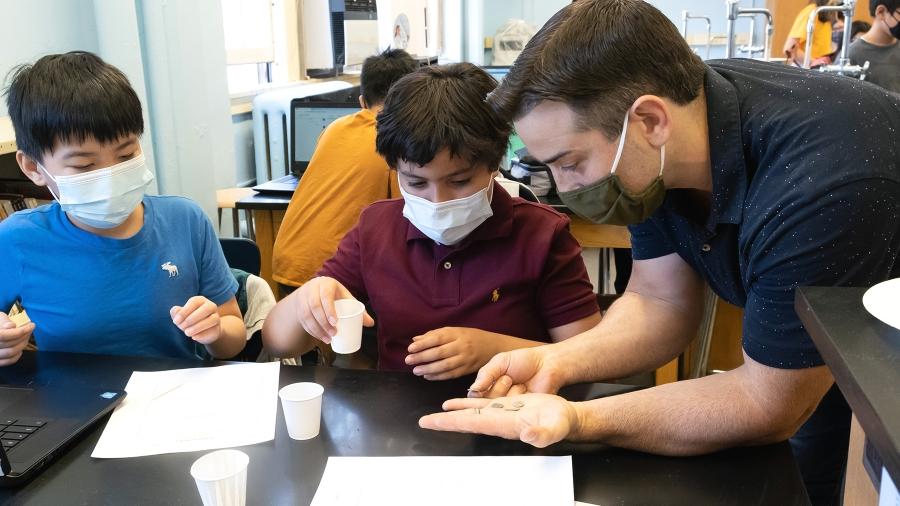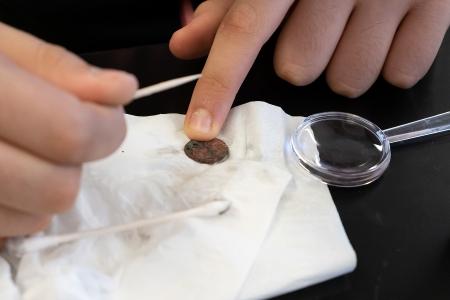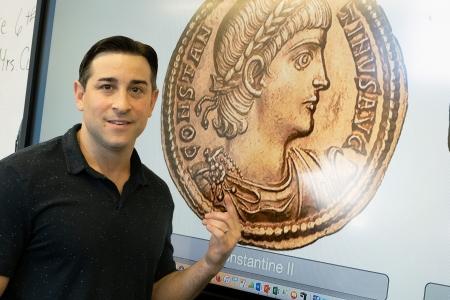Holding history in their hands

Jon Carrai, a history teacher at IS 187 in Brooklyn, examines the symbols on ancient Roman coins with two of his 6th-graders.
On a sultry day in late June, history teacher Jon Carrai at IS 187 in Borough Park, Brooklyn, handed each of his 6th-graders a small Roman coin caked with 2,000 years’ worth of grime.
He first invited students to share their initial, unremarkable observations: “They’re dirty. They’re smaller than I thought they would be.”
Then he lowered his voice to a dramatic whisper. “These coins might be 2,000 years old,” he said. “Imagine whose pocket they might have been in. A gladiator? A senator? Were they used to purchase olive oil or a loaf of bread?”
Immersive, engaging lessons are a hallmark of Carrai’s teaching. To add ambiance to a lesson on ancient Egypt, he dims the lights and plays Egyptian music while students examine and touch artifacts. To keep students engaged during remote learning, he used Google Forms to design virtual “escape rooms.”
“I’m always looking for something to draw them in so they’re excited to see what’s in store for them,” says Carrai. “I do activities that are mission-based, like an adventure. As a kid, I fell in love with history partly due to the Indiana Jones movies. I always want them to feel a little like Indy.”
Carrai didn’t set out to be a swashbuckling professor. A Wall Street broker and trader who found himself disenchanted with finance, he followed the advice of his wife — a prekindergarten teacher — and changed careers. He’s now in his fifth year of teaching at IS 187 in Borough Park, Brooklyn.

A student uses a toothpick to gently remove dirt from a coin.

For Carrai, history is about telling a compelling story.
“Teaching history embodies the perfect mix of academia and my personal passions and sense of adventure,” he says.
His personal passion for ancient coins dovetailed with his unit on ancient civilizations. In his classroom that June day, his 6th-grade students discussed what the symbols on coins can represent about a society. Then they began to use tools to clean the coins Carrai bought online in hopes of observing and identifying the legends on them. Students dropped their coins into a cup of vinegar to loosen the dirt. Then they sprinkled the coins with salt and gently scrubbed them with Q-tips and toothpicks, before finally peering at them through magnifying glasses.
“Remember, the ancient Romans didn’t have Instagram,” Carrai reminded students. “These coins are how they tell their own history.”
History, for Carrai, is ultimately about telling a compelling story.
“When I was in middle school, history was a collection of dates and facts. But when you tell a story, you’re able to connect those things through a narrative,” he says. “When you teach a story that’s compelling, whether it includes a little bit of blood or it smells of incense, that experience stays in students’ heads and so does the concepts they learned. They come away with a visualization of the narrative of history, and it builds a deeper understanding.”
To construct that historical narrative, Carrai frequently asks students to collaborate in groups to solve riddles or make decisions. The scenario may be hypothetical, but the drama is real — and so is the learning that ensues.
“Their destiny links them together and helps them overcome conflict to succeed,” he says.
In a lesson on the geography of ancient Greece, for example, students envisioned themselves as residents of one of Greece’s many autonomous city-states who had to decide whether it was to their advantage to trade and communicate with a neighboring community during a Persian invasion.
“He gives us fun activities but teaches us a lot at the same time,” said 6th-grader Keole. “It’s a good balance.”
That balance of instruction and entertainment was especially important during the challenging 2020–21 school year, when fun was in short supply for many New York City students.
“He really, truly engages kids on a daily basis and knows how to keep them interested,” Jeff Feil, the dean and chapter leader at IS 187, said in a late June interview. “He had a natural feel for what students needed this year especially, and kids cite him as someone who makes them feel comfortable and safe.”
When the bell rang, Carrai encouraged his students to continue cleaning their ancient coins at home using the Online Coins of the Roman Empire database as a resource. When a student wondered aloud how much his coin was worth, Carrai was ready with an answer that would have made Indiana Jones proud.
“Their value doesn’t necessarily represent their historical value,” he said. “These coins were in the pockets of people who were part of history, and now they’re yours to keep.”